Computex 2007: AMD's Barcelona and Other Products
by Gary Key on June 11, 2007 4:00 AM EST- Posted in
- Trade Shows
abit
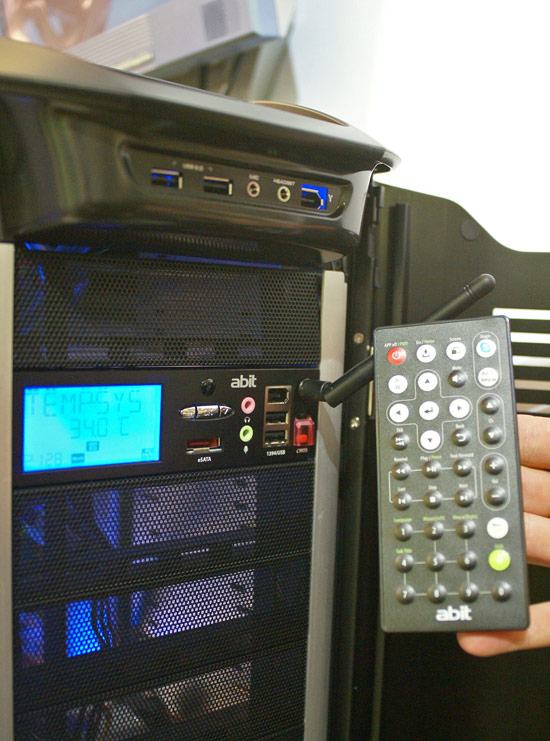
abit was displaying the new version 3.0 of their µGuru panel that features WiFi support. This enables you to control tuning aspects and software applications with the new remote control unit from anywhere in the room. So, if you're sitting in a recliner on the other end of the room and suddenly feel the need to modify your system overclock, you no longer need to get up and cross the room.

While abit showed off an impressive lineup of P35 motherboards that we will review shortly, we found a little gem hiding in the back room of the display booth. The new AN-M2HD is based on the just released NVIDIA 7050/630i chipset combination and should be an excellent overclocker for current AM2 processors as verified in early testing. We will have more on this motherboard and the X38 lineup shortly.
ASUS
ASUS offers a complete line of products for the PC and always has some interesting technology to view at the various tradeshows.
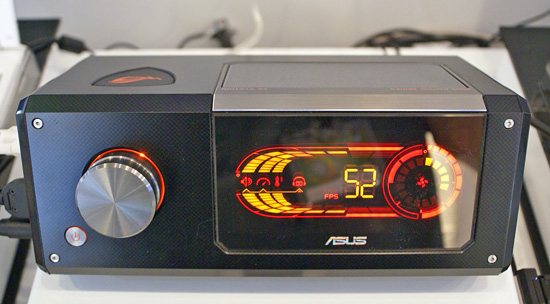
The ASUS XG Station was first shown at CES this year and is a complete external drop in solution for your notebook. The system was demonstrated with an NVIDIA 8600GT and should be ready for market shortly. The delay was caused by additional programming requirements for Vista compatibility along with certification for the latest video card choices.
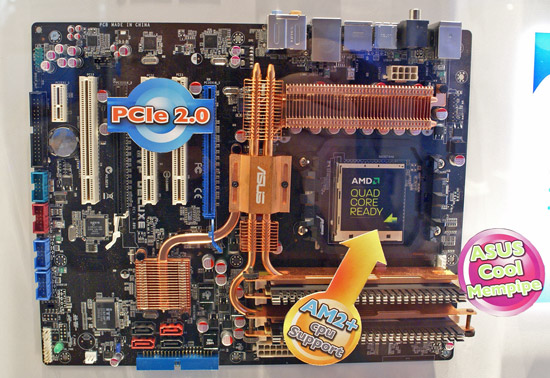
The ASUS M3A32-MVP Deluxe is based on the upcoming AMD RD790 chipset that features full support for AM2/AM2+ processors, HyperTransport 3, CrossFire, and DDR2-1066. The chipset is coming along well although we expect a couple of additional silicon spins before an estimated release date in late September of this year. Hopefully, AMD will be on schedule this time with a chipset introduction, though as mentioned earlier the new Agena based processors may not be available until December. One of the new features that ASUS was touting is the memory heatpipe system that is attached to the Northbridge heatpipe unit. Whether this will make it into in production is unknown at this time, but early thermal results are promising. Unfortunately, the current system only works with two DIMM slots occupied.
MSI
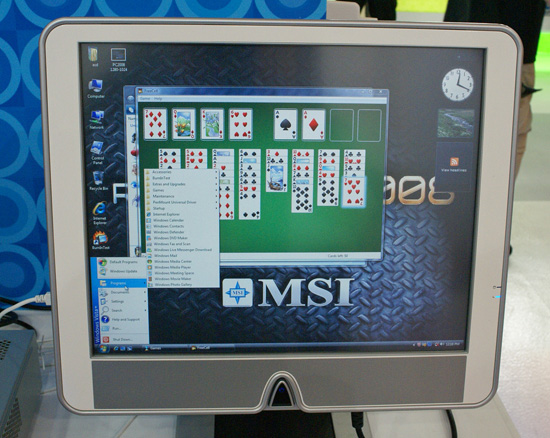
MSI had several new products in their booth this year but the Crystal 945 Touch panel PC caught our eye for those who like an all-in-one PC combination. The unit features the 945G/ICH7 chipset combination, 2GB of DDR2-667 memory, Pentium 4/D support, an 8-in-1 flash card reader, support for 2.5" IDE HDD and Slim design ODD units with a 17" touch screen panel. We found the system was very responsive and intuitive to use for a Windows based PC and it offers a fairly small footprint.
Shuttle
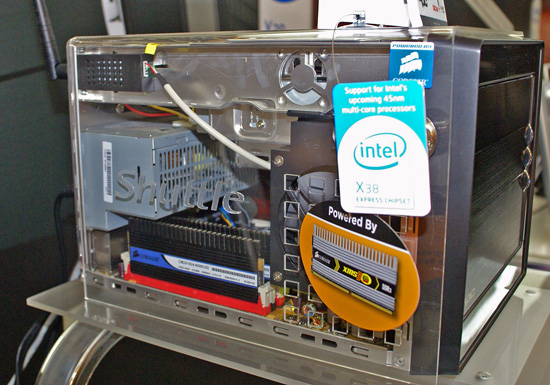
Shuttle was very excited to show off their new SFF unit, the SX38P3 Deluxe. The SX38 is based on Intel's new X38 chipset. Shuttle has managed to fit this chipset along with CrossFire capabilities into a revised SFF case that features their OASIS cooling technology. The system also features dynamic overclocking, 802.11 b/g WiFi, Bluetooth, Fingerprint recognition, and an 80%+ efficient certified power supply.

abit was displaying the new version 3.0 of their µGuru panel that features WiFi support. This enables you to control tuning aspects and software applications with the new remote control unit from anywhere in the room. So, if you're sitting in a recliner on the other end of the room and suddenly feel the need to modify your system overclock, you no longer need to get up and cross the room.

While abit showed off an impressive lineup of P35 motherboards that we will review shortly, we found a little gem hiding in the back room of the display booth. The new AN-M2HD is based on the just released NVIDIA 7050/630i chipset combination and should be an excellent overclocker for current AM2 processors as verified in early testing. We will have more on this motherboard and the X38 lineup shortly.
ASUS
ASUS offers a complete line of products for the PC and always has some interesting technology to view at the various tradeshows.

The ASUS XG Station was first shown at CES this year and is a complete external drop in solution for your notebook. The system was demonstrated with an NVIDIA 8600GT and should be ready for market shortly. The delay was caused by additional programming requirements for Vista compatibility along with certification for the latest video card choices.

The ASUS M3A32-MVP Deluxe is based on the upcoming AMD RD790 chipset that features full support for AM2/AM2+ processors, HyperTransport 3, CrossFire, and DDR2-1066. The chipset is coming along well although we expect a couple of additional silicon spins before an estimated release date in late September of this year. Hopefully, AMD will be on schedule this time with a chipset introduction, though as mentioned earlier the new Agena based processors may not be available until December. One of the new features that ASUS was touting is the memory heatpipe system that is attached to the Northbridge heatpipe unit. Whether this will make it into in production is unknown at this time, but early thermal results are promising. Unfortunately, the current system only works with two DIMM slots occupied.
MSI

MSI had several new products in their booth this year but the Crystal 945 Touch panel PC caught our eye for those who like an all-in-one PC combination. The unit features the 945G/ICH7 chipset combination, 2GB of DDR2-667 memory, Pentium 4/D support, an 8-in-1 flash card reader, support for 2.5" IDE HDD and Slim design ODD units with a 17" touch screen panel. We found the system was very responsive and intuitive to use for a Windows based PC and it offers a fairly small footprint.
Shuttle

Shuttle was very excited to show off their new SFF unit, the SX38P3 Deluxe. The SX38 is based on Intel's new X38 chipset. Shuttle has managed to fit this chipset along with CrossFire capabilities into a revised SFF case that features their OASIS cooling technology. The system also features dynamic overclocking, 802.11 b/g WiFi, Bluetooth, Fingerprint recognition, and an 80%+ efficient certified power supply.










64 Comments
View All Comments
TA152H - Monday, June 11, 2007 - link
And if they had, they would have probably gone with the memory disambiguation of the Core 2, instead of the non-speculative load reordering of the Pentium Pro to III. They may not have realized when they were making it Intel was going to raise the bar.Either way, it's impossible.
Regs - Monday, June 11, 2007 - link
Sure..maybe they just decided to pick up a plan that was considered dead and go through with it. It was all ready reported they were trying to re-spin the K8 before the Core Duo was ever announced though it was cancelled because it was dependent on highly-threaded applications that are simply not coming any time soon.TA152H - Monday, June 11, 2007 - link
That's a different processor design that they killed. But, you bring up a huge misconception that most non-programmers have, that with more work you can get really great performance out of threading. All you have to do is put in the time and rethink how to code. It's utter nonsense, and there is something called Amdahl's Law that is worth reading for people that don't understand or believe this.Some algorithms will work well with threading, many, many will not. So, yes, AMD killed that dog and luckily so. If they came out with that, I'd be really, really worried for the company.
But this new processor isn't anything particulary risky or scary. It's a very nice upgrade in many areas, and considering the K8 is obsolete, but not horrible like the P7, it should turn out to be a fine processor and at the minimum competitive for a while.
6-12 months is absolutely incorrect. If you're saying that because you believe it, you need to do a little more research on this type of thing because it's entirely implausible. If you're saying it because you're frustrated with AMD and just lashing out, I can understand that completely. But, try to keep it in perspective; it's still a good processor but it just has a few problems before it's release.
Regs - Monday, June 11, 2007 - link
Highly frustrated. If this was a long planned project then their execution is well, I guess we have to see. Like the bias before the Opteron launched I guess we should not make the same mistake twice.TA152H - Monday, June 11, 2007 - link
While I can understand your frustration, try to keep a few things in common.This is pre-release silicon, of course, and that might not seem like such an important thing, but keep in mind that EVERY processor on that core has to run at the designated speed. So, if one can run at 2.8 GHz, one at 2.6 GHz, another at 2.3 GHz, and one at 1.8 GHz, you're stuck at 1.8 GHz for the entire part. The margin for error is so small because of native quad core decision, it's not surprising the numbers are so low considering the stage of development it's in. At this point, the manufacturing is still fairly new, the processor is of course very new, and with the low margin for error it's going to look bad. But, AMD is a weird bird, they seem to come out with terrible processors on the first version of a new lithography, and continue to improve it quite a bit, much moreso than Intel does. This and getting less scatter with regards to maximum frequency should allow the Barcelona to improve pretty quickly through the iterative improvements AMD does with their manufacturing.
I can understand why you'd be frustrated, but I think it's early to give up on them compeletely. I think most of it is the sting of going native quad-core right off the bat with a brand new processor architecture. It's a lot to deal with in one shot, especially with a fairly new manufacturing process. They probably should have done one thing at a time, but sooner or later they'll get it right. I don't think it will be too late for it to matter either, but who knows?
Regs - Monday, June 11, 2007 - link
Yes trust me I read a lot of articles about the "Bark". From its symmetric ALU's, down to the non-speculative memory access reordering.I'm not giving up on AMD at all but it's a ton of fun seeing too CPU manufactures diverge. Just like how you talk about how badly your team is doing mid-season, it some how enlightens your hope for them during the post-season.
TA152H - Tuesday, June 12, 2007 - link
Go Yankees?TowerShield - Monday, June 11, 2007 - link
I was figuring the product might have died after it didn't show up in May.Gary Key - Monday, June 11, 2007 - link
It worked beautifully under XP Pro with my laptop, Vista compatibility still needs some fine tuning before the unit is launched. ASUS is intent on completing the project within the next four to six weeks.poisondeathray - Monday, June 11, 2007 - link
Is the XG Station still designed with the Express Card interface (480Mbit or 2.5Gbit depending on USB or PCI Express)?What impact on high resolution gaming does this limited interface bandwith present?